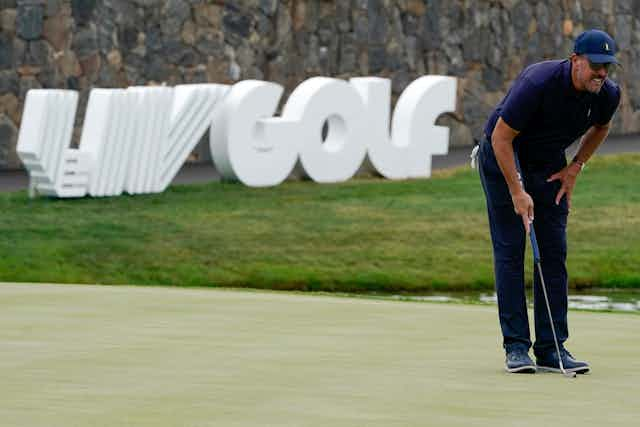In June 2022, Greg Norman, a former world No. 1 golfer, became the public face of LIV Golf — a tour backed by the Saudi Public Investment Fund (PIF) that pledged to “holistically improve the health of professional golf on a global scale.”
The fact that such an accomplished professional chose to represent the tour was an early indicator of the reach and prominence it would soon have across the sport.
Only one year later, LIV Golf — and the Saudi sovereign wealth fund that finances it — are now official partners with the PGA Tour.
The merger has caused the PGA Tour to formally acknowledge LIV Golf as both its equal and partner. The PGA Tour has both validated and enshrined LIV Golf as a legitimate, powerful presence within the sport. By extension, the PIF has been granted a full-time seat at the international sporting table.
LIV Golf has gone from a renegade tour that attracted top players away from the PGA Tour to becoming a legitimate partner that will shape the future of the organization it sought to compete with only one year ago.
New partnership
The PGA Tour isn’t simply swallowing up a fledgling, unsuccessful competitor, which is what usually happens in professional sports. Instead, they are forming a genuine partnership with the PIF.
The language of the agreement makes this clear:
“PIF will initially be the exclusive investor in the new entity, alongside the PGA TOUR, LIV Golf and the DP World Tour. Going forward, PIF will have the exclusive right to further invest in the new entity, including a right of first refusal on any capital that may be invested in the new entity, including into the PGA TOUR, LIV Golf and DP World Tour.”
Leading up to the union, many in the golf community aired their unease about LIV Golf and what this move represented for the sport’s development.
After winning the 2022 Canadian Open last June, Rory McIlroy, who has been one of the PGA Tour’s most staunch defenders and LIV Golf’s most outspoken critics, said:
“What [LIV] are doing over there doesn’t really mean anything apart from just collecting a ton of money.”

The question of finances has been central to the premise and promise of LIV Golf since its creation. The last place finisher at the 2023 Charles Schwab Challenge in May earned about US$17,000.
At the LIV Golf tournament held in the same month, the last place finisher earned US$127,000, while the winner took home US$4,000,000, a whopping US$3.5 million more than the Schwab winner.
Such calculations have caused many to openly question why the LIV tour — which features many excellent athletes but not necessarily the world’s top golfers — was comfortable paying potentially inferior players considerably more money.
Inflated salaries
A foundational principle of sport that is becoming quainter with each passing day is that an athlete, team or league possesses a quantifiable value that directly relates to their salary.
This value can be enhanced by successes on and off the field, priced into budgets, traded and exchanged, all while being managed within the complex dynamics of a sports entertainment industry.
This notion that some grand ledger exists which calculates the precise value of a player or team is a useful illusion. It has been used to pay athletes less money based on some false idea of their inherent worth.
Over the past decade, Saudi involvement in sports has revealed some of the smoke and mirrors that make this illusion possible. The Saudi willingness to overpay as a means of attracting athletes has led to an overvaluation of talent and inflated salaries that other leagues have struggled to match.
Like any business, professional sports are not typically eager to pay beyond market value for their employees. The bloated salaries handed out through LIV Golf irrevocably skewed perceptions and expectations around athlete salaries.
But perhaps more distressingly, the underlying exchange behind these payouts reveals the possible use of professional golf as an expensive smokescreen to help obscure or distract from larger controversies.
Unsavoury sport money
It would be naive to believe this is the first instance of unsavoury money flowing into the coffers of professional sport organizations.
However, it is important to note that the PIF is not simply purchasing a seat at the table: it is altering the blueprints, re-wiring the building and adding a pool to the backyard.
Just a year ago, PGA Tour officials and players were dead-set against the incursion of Saudi money into the game, for both legitimate and contrived reasons.
By forming this partnership, the PGA Tour seems to be priortizing financial interests over ethical ones. Despite Saudi Arabia’s ongoing human rights issues, the PGA Tour has still chosen to align itself with the Saudis.
The rivalry between the PGA Tour and the Saudi-funded LIV Golf ends not with a bang, but with a merger. It’s clear both sides are far more interested in “collecting a ton of money” than issues of morality. What remains to be seen is the future of the sport, and the fate of its athletes, now that these priorities have been laid bare.
This is a corrected version of a story originally published on June 12, 2023. The previous version incorrectly used PGA in the headline and body of the article instead of PGA Tour. The PGA of America split from the PGA Tour in 1968 and had nothing to do with the PGA Tour merger.

